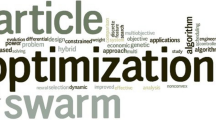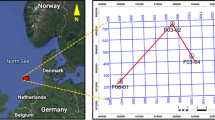Abstract
This study established the Kriging model to simplify the mathematical model for calculations and to improve the operational efficiency of global optimization in seismic exploration engineering. Accordingly, wireless seismic sensor network (WSSN) was used as an example in this research, and the generated seismic data flow rate and the flow rate of seismic data transmission are the simulation sample points. Thereafter, the Kriging model was constructed and the function was fitted. An improved particle swarm optimization (PSO) was also utilized for the global optimization of the Kriging model of WSSN to determine the optimized network lifetime. Results show that the Kriging model and the improved PSO algorithm significantly enhanced the lift performance and computer operational efficiency of WSSN.









Similar content being viewed by others
References
Venter, G., Haftka, R. T., & Starnes, Jr J. H. (1996). Construction of response surfaces for design optimization applications[C]//. In Proceedings of 6-th AIAA/NASA/ISSMO symposium on multidisciplinary and structural optimization (pp. 548–564).
Balabanov, V. O. (1997) Development of approximations for HSCT wing bending material weight using response surface methodology.
Shan, D., Cao, G. H., & Dong, H. J. (2013). LGMS-FOA: an improved fruit fly optimization algorithm for solving optimization problems. In Mathematical problems in engineering.
Ren, K., & Qu, J. (2014). Identification of shaft centerline orbit for wind power units based on Hopfield neural network improved by simulated annealing. In Mathematical problems in engineering.
Kwon, O. M., Park, M. J., Park, J. H., et al. (2014). On less conservative stability criteria for neural networks with time-varying delays utilizing Wirtinger-based integral inequality. In: Mathematical Problems in Engineering.
Chen, W., & Sitaraman, S. K. (2014). Response surface and multiobjective optimization methodology for the design of compliant interconnects. IEEE Transactions on Components, Packaging and Manufacturing Technology, 4, 1769–1777.
Chang, K. H. (2015). Improving the efficiency and efficacy of stochastic trust-region response-surface method for simulation optimization. IEEE Transactions on Automatic Control, 60, 1235–1243.
Reykherdt, A. A., & Kadomskaya, K. P. (2015). An engineering approach to calculation of channel-base lightning current parameters. IEEE Transactions on Dielectrics and Electrical Insulation, 22, 815–821.
Kerwin, W. S., & Prince, J. L. (1999). The kriging update model and recursive space-time function estimation [J]. IEEE Transactions on Signal Processing, 47, 2942–2952.
Matheron, G. (1963). Principles of geostatistics. Economic Geology, 58, 1246–1266.
Giunta, A. A. (1997) Aircraft multidisciplinary design optimization using design of experiments theory and response surface modeling methods. Virginia Polytechnic Institute and State University.
.Simpson, T. W., et al. (1998). Comparison of response surface and kriging models for multidisciplinary design optimization[C]//. American Inst. of Aeronautics and Astronautics; Reston, VA, United States.
Giunta, A. A., Watson, L. T. (1998). A comparison of approximation modeling techniques: polynomial versus interpolating models[C]//. American Inst. of Aeronautics and Astronautics; Reston, VA, United States.
Simpson, T. W. (1998) Comparison of response surface and kriging models in the multidisciplinary design of an aerospike nozzle[C]//. Institute for Computer Applications in Science and Engineering; Hampton, VA United States.
Lucifredi, A., Mazzieri, C., & Rossi, M. (2000). Application of multi-regressive linear models, dynamic kriging models and neural network models to predictive maintenance of hydroelectric power systems. Mechanical Systems and Signal Processing, 14, 471–494.
Costa, J. P., Pronzato, L., Thierry, E. (1999). A comparison between Kriging and radial basis function networks for nonlinear prediction [C]//NSIP (pp. 726–730).
Singla, P., Subbarao, K., & Junkins, J. L. (2007). Direction-dependent learning approach for radial basis function networks. IEEE Transactions on Neural Networks, 18, 203–222.
Lei, X., & Lu, P. (2014). The adaptive radial basis function neural network for small rotary-wing unmanned aircraft. IEEE Transactions on Industrial Electronics, 61, 4808–4815.
Kersaudy, P., Sudret, B., Varsier, N., et al. (2015). A new surrogate modeling technique combining Kriging and polynomial chaos expansions–Application to uncertainty analysis in computational dosimetry[J]. Journal of Computational Physics, 286, 103–117.
Pan, I., & Das, S. (2015). Kriging based surrogate modeling for fractional order control of microgrids[J]. IEEE Transactions on Smart Grid, 6(1), 36–44.
Sharma, S., Bhattacharjee, S., & Bhattacharya, A. (2016). Grey wolf optimisation for optimal sizing of battery energy storage device to minimise operation cost of microgrid[J]. IET Generation, Transmission and Distribution, 10(3), 625–637.
Larumbe, F., & Sanso, B. (2013). A tabu search algorithm for the location of data centers and software components in green cloud computing networks[J]. IEEE Transactions on Cloud Computing, 1(1), 22–35.
Kwon, S., & Shroff, N. B. (2012). Energy-efficient unified routing algorithm for multi-hop wireless networks. IEEE Transactions on Wireless Communications, 11, 3890–3899.
Singh, S., Chand, S., & Kumar, B. (2016). Energy efficient clustering protocol using Fuzzy logic for heterogeneous WSNs[J]. Wireless Personal Communications, 86(2), 451–475.
Huang, D.-N., Yu, P., Di, Q.-Y., Guo, Z.-Q., Lin, J., Sun, Y.-H., et al. (2012). Development of key instruments and technologies of deep exploration today and tomorrow. Journal of Jilin University (Earth Science Edition), 42(5), 1485–1496.
Lophaven, S. N., Nielsen, H. B., Sondergaard, J. (2002) DACE—a Matlab Kriging toolbox; version 2; informatics and mathematical modelling [J]. Technical University of Denmark, Technical Report No. IMM-TR-2002-12.
Acknowledgements
This study is supported by the National Research Foundation of China under Grant (SinoProbe-09-04, No: 201011081). The authors are very thankful to the anonymous reviewers for their constructive comments and suggestions which greatly improve the quality of this paper.
Author information
Authors and Affiliations
Corresponding author
Rights and permissions
About this article
Cite this article
Tong, X., Lin, J., Ji, Y. et al. Global Optimization of Wireless Seismic Sensor Network Based on the Kriging Model and Improved Particle Swarm Optimization Algorithm. Wireless Pers Commun 95, 2203–2222 (2017). https://doi.org/10.1007/s11277-017-4051-4
Published:
Issue Date:
DOI: https://doi.org/10.1007/s11277-017-4051-4




